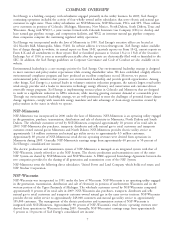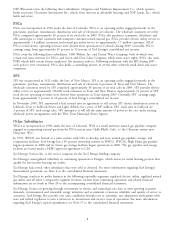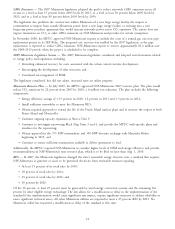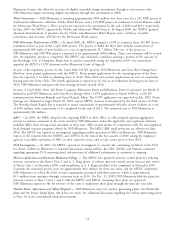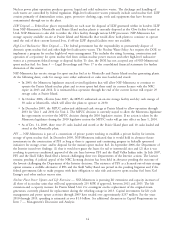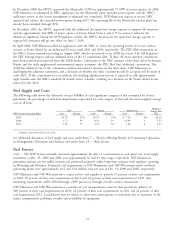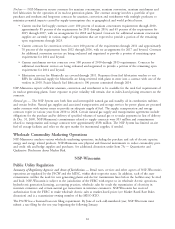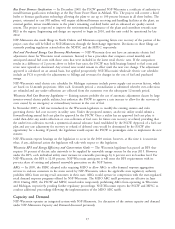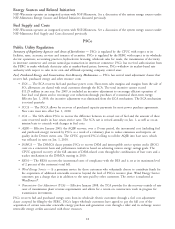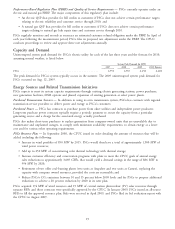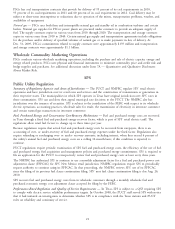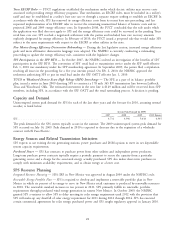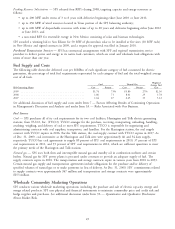Xcel Energy 2009 Annual Report Download - page 24
Download and view the complete annual report
Please find page 24 of the 2009 Xcel Energy annual report below. You can navigate through the pages in the report by either clicking on the pages listed below, or by using the keyword search tool below to find specific information within the annual report.Nuclear power plant operation produces gaseous, liquid and solid radioactive wastes. The discharge and handling of
such wastes are controlled by federal regulation. High-level radioactive wastes primarily include used nuclear fuel. LLW
consists primarily of demineralizer resins, paper, protective clothing, rags, tools and equipment that have become
contaminated through use in the plant.
LLW Disposal — Federal law places responsibility on each state for disposal of LLW generated within its borders. LLW
from NSP-Minnesota’s Monticello and Prairie Island nuclear plants is currently disposed at the Clive facility located in
Utah. NSP-Minnesota is also able to utilize the Clive facility through various LLW processors. NSP-Minnesota has
storage capacity available on-site at Prairie Island and Monticello that would allow both plants to continue to operate
until the end of their current licensed lives, if off-site LLW disposal facilities were not available.
High-Level Radioactive Waste Disposal — The federal government has the responsibility to permanently dispose of
domestic spent nuclear fuel and other high-level radioactive wastes. The Nuclear Waste Policy Act requires the DOE to
implement a program for nuclear high-level waste management. This includes the siting, licensing, construction and
operation of a repository for spent nuclear fuel from civilian nuclear power reactors and other high-level radioactive
wastes at a permanent federal storage or disposal facility. To date, the DOE has not accepted any of NSP-Minnesota’s
spent nuclear fuel. See Item 3 — Legal Proceedings and Note 17 to the consolidated financial statements for further
discussion of this matter.
NSP-Minnesota has on-site storage for spent nuclear fuel at its Monticello and Prairie Island nuclear generating plants.
At the following dates, casks for storage were either authorized or casks were loaded and stored:
• In 2003, the Minnesota legislature enacted revised legislation that will allow NSP-Minnesota to continue to
operate the Prairie Island nuclear plant and to store spent fuel there until its current licenses with the NRC
expire in 2013 and 2014. It is estimated that operation through the end of the current license will require 29
storage casks at Prairie Island.
• In October 2006, effective June 2007, the MPUC authorized an on-site storage facility and dry cask storage of
30 casks at Monticello, which will allow the plant to operate to 2030.
• In December 2009, the MPUC authorized additional cask storage at Prairie Island to allow operation through
2033 for Unit 1 and 2034 for Unit 2. The MPUC decision is currently stayed to allow the Minnesota legislature
the opportunity to review the MPUC decision during the 2010 legislative session. If no action is taken by the
Minnesota legislature during the 2010 legislative session the MPUC order will go into effect on June 1, 2010.
• As of Dec. 31, 2009, there were 25 casks loaded and stored at the Prairie Island plant and 10 casks loaded and
stored at the Monticello plant.
PFS — NSP-Minnesota is part of a consortium of private parties working to establish a private facility for interim
storage of spent nuclear fuel. In December 2005, NSP-Minnesota indicated that it would hold in abeyance future
investments in the construction of PFS as long as there is apparent and continuing progress in federally sponsored
initiatives for storage, reuse, and/or disposal for the nation’s spent nuclear fuel. In September 2006, the Department of
the Interior issued two findings: (1) that it would not grant the leases for rail or intermodal sites and (2) that it was
revoking its previous conditional approval of the site lease between PFS and the Skull Valley Indian tribe. In July 2007,
PFS and the Skull Valley Band filed a lawsuit challenging these two Departments of the Interior actions. The lawsuit
remains pending. A judicial appeal of the NRC licensing decision has been held in abeyance pending the outcome of
the lawsuit challenging the Department of the Interior decisions. The existence of PFS as a licensed out-of-state storage
option remains a credible alternative if PFS and the Skull Valley Band can prevail in the pending litigation and if the
federal government fails to make progress with their obligation to take title and remove spent nuclear fuel from Xcel
Energy’s and other nuclear reactor sites.
Nuclear Plant Power Uprates and Life Extension — NSP-Minnesota is pursuing life extensions and capacity increases of
all three of its nuclear units that will total approximately 235 MW, if approved, between 2011 and 2015. The life
extension and a capacity increase for Prairie Island Unit 2 is contingent on the replacement of the original steam
generators, currently planned for replacement during the refueling outage in 2013. Capital investments for life cycle
management and power uprate activities through 2009 have totaled over approximately $257 million. For the years
2010 through 2015, spending is estimated at over $1.0 billion. See additional discussion in Capital Requirements in
Item 7 — Management’s Discussion and Analysis.
14





